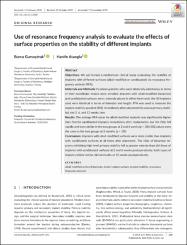| dc.contributor.author | Gürsoytrak, Burcu | |
| dc.contributor.author | Ataoğlu, Hanife | |
| dc.date.accessioned | 2020-01-03T06:43:27Z | |
| dc.date.available | 2020-01-03T06:43:27Z | |
| dc.date.issued | 2020 | en_US |
| dc.identifier.citation | Gürsoytrak, B. ve Ataoğlu, H. (2020). Use of resonance frequency analysis to evaluate the effects of surface properties on the stability of different implants. Clinical Oral Implants Research, 31(3), 239-245. https://doi.org/10.1111/clr.13560 | en_US |
| dc.identifier.issn | 0905-7161 | |
| dc.identifier.issn | 1600-0501 | |
| dc.identifier.uri | https://doi.org/10.1111/clr.13560 | |
| dc.identifier.uri | https://hdl.handle.net/20.500.12511/4882 | |
| dc.description.abstract | Objectives We performed a randomized clinical study evaluating the stability of implants with different surfaces (alkali-modified or sandblasted) via resonance frequency analysis (RFA). Materials and Methods Fourteen patients who were bilaterally edentulous in terms of their mandibular molars were enrolled. Implants with alkali-modified (bioactive) and sandblasted surfaces were randomly placed in either hemi-arch; the 50 implants used were identical in terms of diameter and length. RFA was used to measure the implant stability quotient (ISQ) immediately after placement (to assess primary stability) and 2, 6, and 12 weeks later. Results The average RFA value for alkali-modified implants was significantly higher than that for sandblasted implants immediately after implantation, but the ISQs fell rapidly and were similar in the two groups at 2 and 6 weeks (p > .05); ISQ values were the same in the two groups at 3 months (p > .05). Conclusions Implants with alkali-modified surfaces were more stable than implants with sandblasted surfaces at all times after placement. The ISQs of bioactive implants exhibiting high-level primary stability fell to greater extents than did those of implants with sandblasted surfaces at 2 and 6 weeks postoperatively; both types of implant yielded similar clinical results at 12 weeks postoperatively. | en_US |
| dc.description.sponsorship | Selcuk University | |
| dc.language.iso | eng | en_US |
| dc.publisher | Wiley | en_US |
| dc.rights | info:eu-repo/semantics/embargoedAccess | en_US |
| dc.subject | Alkali-Modified Surfaced Implants | en_US |
| dc.subject | Dental Implant Surface | en_US |
| dc.subject | Implant Stability | en_US |
| dc.subject | Resonance Frequency Analysis | en_US |
| dc.title | Use of resonance frequency analysis to evaluate the effects of surface properties on the stability of different implants | en_US |
| dc.type | article | en_US |
| dc.relation.ispartof | Clinical Oral Implants Research | en_US |
| dc.department | İstanbul Medipol Üniversitesi, Diş Hekimliği Fakültesi, Ağız, Diş ve Çene Cerrahisi Ana Bilim Dalı | en_US |
| dc.authorid | 0000-0003-3555-0064 | en_US |
| dc.identifier.volume | 31 | en_US |
| dc.identifier.issue | 3 | en_US |
| dc.identifier.startpage | 239 | en_US |
| dc.identifier.endpage | 245 | en_US |
| dc.relation.publicationcategory | Makale - Uluslararası Hakemli Dergi - Kurum Öğretim Elemanı | en_US |
| dc.identifier.doi | 10.1111/clr.13560 | en_US |
| dc.identifier.wosquality | Q1 | en_US |
| dc.identifier.scopusquality | Q1 | en_US |


















